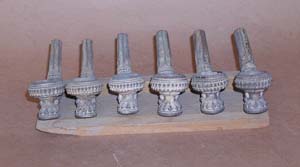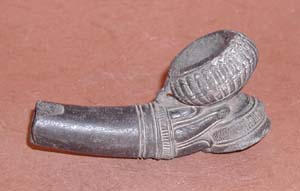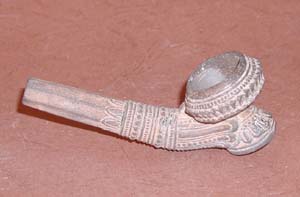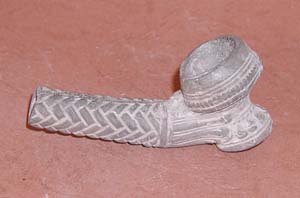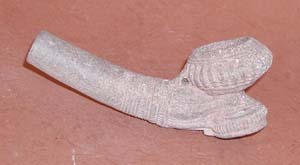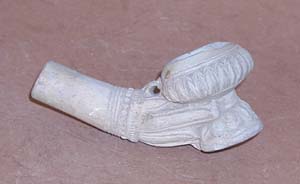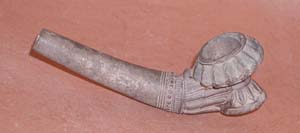| |
| |
|
|
| |
Pipes introduction
The study of Burmese pipes, and indeed of other pipes made in Laos and Thailand, revolves around the fact that a single pipe, presumably the possession of a crew member, was found on the Vergulde Draeck, a Dutch ship that sank off the west coast of Australia in 1656. The six pipes shown here and found at Chiang Dao are identical to the Vergulde Draeck pipe.
Don Hein in his 1997 thesis at Monash University describes these pipes in great detail.
The kilns were situated at Tada-U near the old capital of Ava. The pipes were made in moulds but often also subsequently carved. Characteristically they had a flat base. They were stoneware, fired at some 1000 degrees centigrade. A long bamboo or reed tube would have been attached to the stem. A few pipes were glazed. Similar pipes, but of a distinct style, were made at Sisattanak just outside Vientiane in Laos. A few pipes attributed to Luang Prabang, Kalong, the Shan States and Arakan have been reported.
Tobacco was probably introduced to the area early in the sixteenth century, possibly via The Philippines by the Spaniards or via India by the Portugese. Certainly the idea of using a pipe is of American Indian origin.
Three interesting questions are.-
Why were pipes made in moulds when no other contemporary ceramics were made in this way in the region? The answer may lie in the few bronze pipes that are known. The metal-like appearance of the stoneware pipes is clear. Bronze pipes would smoke much too hot to be practical.
In most of Southeast Asia to the south, cigars were smoked. Why not also in the northern inland areas? Martin Nijhof, a world authority on tobacco, says that cigars are much the best way to smoke but that it is essential that the wrapper leaf be of good quality - hence the fame of Havanna's, Dominicans and Sumatrans. No suitable leaves were then, or indeed are today, available in these northern regions of Asia. Hence an alternative vehicle had to be found - the pipe. Poor people then, as now, probably made do with smoking their tobacco wrapped in a palm leaf, but the result could not be pleasant. Sir John Bowring, writing in 1855, says that tobacco is universally used and adds,'some of the opulent smoke the long pipe.'
Why were the pipes fitted with a long extention tube? The answer is propably that the small u-shaped bowl, set at a steep angle to the stem, would have burned very hot; the long tube would have cooled the smoke.
Writing about Pegu in 1727 Alexander Hamilton said, 'The quality of an officeris known by his tobacco pipe having an earthen or metallic head, with a socket to let in a jointed reed, that on its upper end has a mouthpiece of gold, jointed as the reed or cane is, and by the numberof joints in the golden mouthpiece the quality of the officer is known.' |
|
| |
|
|
|
|

